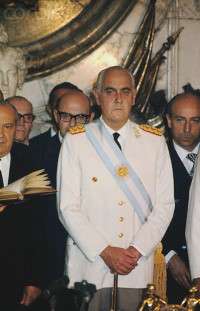Alejandro Agustín Lanusse
Alejandro Agustín Lanusse (August 28, 1918 – August 26, 1996) was the president of the Argentine Republic between March 22, 1971, and May 25, 1973, during the Argentine Revolution.
Alejandro Lanusse | |
|---|---|
 | |
| President of Argentina De facto | |
| In office March 22, 1971 – May 24, 1973 | |
| Preceded by | Roberto M. Levingston |
| Succeeded by | Héctor Cámpora |
| Personal details | |
| Born | Alejandro Agustín Lanusse August 28, 1918 Buenos Aires, Argentina |
| Died | August 26, 1996 (aged 77) Buenos Aires, Argentina |
| Nationality | Argentine |
| Political party | none |
| Profession | Military |
| Signature | .jpg) |
| Military service | |
| Allegiance | Argentina |
| Branch/service | Argentine Army |
| Years of service | 1938–1973 |
| Rank | Lieutenant General |
Early life
He was born as Alejandro Agustín Lanusse Gelly on August 28, 1918, in Buenos Aires to his parents Luis Gustavo Lanusse Justo and Albertina Gelly Cantilo.
Career
A graduate of the Army Academy (Colegio Militar de la Nación, class of 1938), he served in different Cavalry units before becoming commander of the Regimiento de Granaderos a Caballo (Regiment of Horse Grenadiers, presidential escort unit). In 1951 he was sentenced to life imprisonment for his part in an attempted coup to overthrow Juan Perón. He was released in 1955 with the Revolución Libertadora, a military uprising which ousted General Perón and set up a military dictatorship which was in power from 1955 to 1958. In 1956 he was designated Ambassador to the Holy See. In 1960 he became Assistant Director of the Superior Military School and later Commander of the First Armored Cavalry Division. In 1962 he took part in the overthrowing of president Arturo Frondizi, and in 1966 supported General Juan Carlos Onganía in the ousting of president Arturo Illia. In 1968 Lanusse became Commander-in-Chief of the Argentine Army.
Presidency

Lanusse became president of Argentina in 1971. During his administration he established diplomatic relations with China and continuously faced political unrest, with an increase in guerrilla activity. Many political opponents were jailed, and Lanusse decided to negotiate with the Montoneros (a Peronist guerrilla movement) for the return of the corpse of Evita (Eva Duarte de Perón), the legendary second wife of Juan Domingo Perón, whose body had been hidden by the "Revolución Libertadora". On August 22, 1971, several imprisoned guerrillas attempted to escape from the Naval Base of Rawson in Patagonia, and were executed without trial in the Trelew massacre. In 1973 presidential elections were held, and won by Hector Cámpora.[1][2]
Later years
In 1985 Lanusse published his autobiography and criticized the human rights violations that took place during the Dirty War, including the state murder of his cousin, diplomat Elena Holmberg.[3] He was placed under house arrest in 1994 for criticizing president Carlos Menem in a magazine interview.
References
- "El Historiador :: Documentos históricos :: Lanusse y el GAN". Elhistoriador.com.ar. Archived from the original on 2010-08-17. Retrieved 14 October 2017.
- "Archived copy". Archived from the original on 2009-09-08. Retrieved 2010-02-11.CS1 maint: archived copy as title (link)
- El Libro de el diario del juicio (in Spanish). Editorial Perfil. 1985. p. 43. ISBN 9789506390068. Retrieved December 27, 2018 – via Google Books.
External links

| Wikimedia Commons has media related to Alejandro Agustín Lanusse. |
- "Alejandro Agustín Lanusse". Find a Grave. Retrieved June 3, 2013.
| Political offices | ||
|---|---|---|
| Preceded by Roberto Levingston |
President of Argentina 1971–1973 |
Succeeded by Héctor Cámpora |